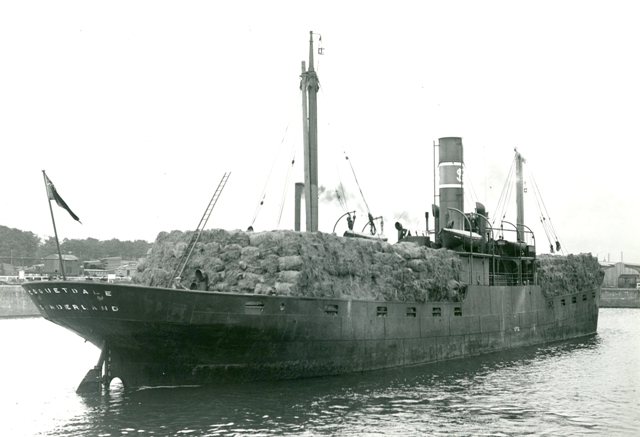Vessel History
The Coquetdale was a British steel screw steamship built by J Priestman & Company in Sunderland in 1923. It was designed for the coal and timber trade, measured 245ft by 37ft by 18ft 3in and had tonnage of 1597 gross. It was powered by a triple expansion three cylinder engine with two single ended boilers, generating 186 nominal hp. When war was declared the ship was armed with 4 Lewis machine guns.
Coquetdale sailed from Falmouth with a cargo of coal on 31st July 1940, as part of Convoy CE8, bound for Southend-on-Sea. In fact she broke away from that convoy and berthed at Portsmouth to unload, intending to return to Falmouth with Convoy CW9 (codenamed Peewit) as it sailed west a few days later. At 4.30am on 8th August, in company with five other merchant vessels (led by the Balhama), Coquetdale left St Helen’s Roads to the east of the Isle of Wight to rendezvous with Convoy CW9. From there Coquetdale was due to sail to the Clyde.

The six ships arrived at the rendezvous of St Catherine’s Point at 7.18am, but did not find the convoy. CW9 had actually been attacked during the night by German S-Boats (known as E-Boats by the British) and as a result was behind schedule. At 8.30am, several squadrons of Junkers Ju 87 Stuka dive bombers, escorted by Messerschmitt Bf 109 fighters left Cherbourg to attack CW9 in the channel. At 9am they instead came across the six ships south of the Isle of Wight and attacked them. Hurricanes of 145 Squadron met the enemy aircraft and severe dogfighting took place overhead, but the Germans’ superior numbers allowed them to bomb the ships almost at will.
Captain Harvey recalled that at approximately 9.10am, they were steering west at approximately eight knots, about 15 miles south west of St Catherine’s Point. Aircraft were seen above and to starboard, which swooped down almost vertically and began bombing. Several of the first series of bombs hit the ship and the captain ordered the engines stopped in order to assess the damage. They briefly restarted the engines, intending to go to the aid of the Ajax which was sinking nearby, but several more bombs struck the Coquetdale. The engine room flooded and the steam was shut off. Several more bombs struck the ship and aircraft strafed the deck. The aft deck gun was blown apart and several bombs hit amidships which blew out the whole port side. The vessel sank soon after along with the Ajax, although the entire crew survived with only two wounded. The other four vessels were all badly damaged. Another five vessels of CW9 were also destroyed and almost all of the rest damaged.
Site Overview
The site of Coquetdale is located at a depth of 40m on hard gravel and is surrounded by an area of slight scour. The wreck is approximately 67m in length, with a beam of 10.8m, and lies on its port side. The maximum height of the wreck above the seabed is 6m, with two large boilers having the greatest vertical expression. This site information has been provided by Mr David Wendes, a local maritime historian who has carried out extensive archival research on the vessel. The results of this research can be viewed in: Wendes, D. 2006. South Coast Shipwrecks off East Dorset and Wight: 1870-1979.
Prior to summer 2010, no previous archaeological survey had been made of the wreck site, but it is a popular dive site and has been frequently visited by sports divers. The vessel’s identity has been assumed as the wreck is within two miles of the reported position of loss and the damage to the hull is consistent with the survivors’ description of the bomb damage.
Latest Investigations
Archaeological assessments were conducted on the Coquetdale site in 2010 as part of the Archaeological Atlas of the 2 Seas project. Divers accessed the wreck from the dive boat Wight Spirit in the window of slack or near slack water. The main purpose of the dives were to confirm the position, extent, stability and character of the site. The visibility was around 8m, sufficient to allow a video record to be made of the site. This footage shows there is great amount of scattered material covering the site and that large parts of the stern section are still covered in sand. An accurate survey was made in order to confirm the extent of the wreckage and taped measurements of observed archaeological features were recorded.
The hull is recognisable, but the midships hull plates on the starboard side are peeled open, testament to the violence of the explosions that sank the vessel. At the stern, close to the propeller, the plates have fallen out from the vessel on the starboard side. The mast has fallen away from the main wreckage on the starboard side, close to the engines and boilers.
